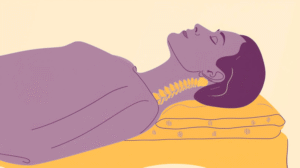Rising up with a stiff neck, dull headaches, or backache is infuriating when all you desired was to get good sleep. The majority of people spend years complaining about their bed or sleeping posture, unaware that the issue could be due to their pillow. Your bed does have some responsibility towards spinal well-being, but so does your pillow.It holds your neck and head for a number of hours during nighttime, affecting your posture, tension, and even nighttime breathing. When your pillow is not supportive, it can cause chronic pain, poor sleep, and long-term health outcomes.
If you’re using a regular pillow and still waking up tired or achy, it might be time to consider a cervical pillow. These specially designed pillows are not just a solution for neck pain, they’re a gateway to improved sleep posture, better circulation, and even enhanced mental clarity. While cervical pillows can be prescribed to provide support for your neck and neck region at certain times, their full range of support in actuality is much, much broader than that, reaching your entire musculoskeletal system and overall wellbeing in general. Now, they are being recommended far and wide throughout physiotherapy, chiropractic, and sleep medicine for any body who wants to maximize sleeping comfort and long-term health benefit.
How Is a Cervical Pillow Different from Regular Pillows?
Unlike regular pillows that offer a soft surface on which to place your head, cervical pillows have been designed to provide the natural concave shape of your neck. They are designed with higher edges and a depression in the middle to enable the neck and properly align the spine. The contouring aspect provides for optimal spinal alignment, and this can also relieve pressure from pressure points and reduce tension in muscles and joints.
The special thing about cervical pillows is that they pay a great deal of attention to biomechanics. Regular pillows will eventually become flat and push the head into asymmetrical positions or get in the way of the inherent curvature of the cervical spine. Cervical pillows, however, can be made to stay firm and offer directed support that is aligned with your sleeping preference. Whether one is a side sleeper or a back sleeper, the setup maintains your spine, neck, and head in the correct position during sleep, thus healthier sleep and reduced instances of waking up stiff.
What Are the Lesser-Known Benefits of Cervical Pillows?
1. Improves Spinal Alignment
Cervical pillows are designed to maintain support for the cervical spine, which comprises the seven vertebrae in the neck. By aligning the natural curve of your neck and repositioning it to the rest of your spine, such pillows also realign postural distortion. Cervical spine alignment has been found to be crucial in alleviating musculoskeletal pain and enhancing neural function [1]. Spine that is well-aligned will also remove pressure from the nerves, thus less numbness and tingling in the arms. Lastly, this avoids degenerative spine changes in the long term.
2. Reduces Shoulder and Back Pain
Shoulder or backache is not what everyone would think of about their pillow first, but a lack of support for the neck can cause the shoulders to fold inward at night and put tension on the upper back. A cervical pillow distributes the load evenly and maintains the shoulders in a neutral position, evading strain and inflammation [2]. This equal weight distribution will also release shoulder blade knots and tension. Sleeping aligned could have you waking up with less pain during the day.
3. Enhances Sleep Posture
Proper sleep posture isn’t solely about sleeping. Proper sleep posture also includes alignment from head to pelvis in neutral position. A cervical pillow maintains this position, especially for back and side sleepers, by tilting and padding the head and neck to avoid awkward angles. Correct posture while sleeping can decrease muscle tension and allow your body to heal itself during sleep [3]. Keeping the spine in this position also decreases the chances of sleep restlessness and nighttime awakenings. Proper sleep posture helps promote proper spinal habits even when awake.
4. Aids in Migraine and Headache Relief
Tension headaches and migraines can often be made worse by over-tensed neck muscles and sleeping in the wrong position. According to studies, cervical support has been found to be very effective in decreasing frequency and severity of tension-type headache [4]. By relaxing muscular tension, a cervical pillow can permit you to sleep in without headache. Diminishing cervical tension may also enhance oxygenation and cerebral circulation. These may decrease sensitivity to light and sound, two prevalent migraine symptoms.
5. Helps with Snoring and Sleep Apnea
Poor head and neck positioning during sleeping can close airways, resulting in snoring and minor sleep apnea. Cervical pillows elevate the head slightly and align the airway, reducing resistance to airflow. A clinical trial indicated that optimized head and neck positioning had a considerable decrease in snoring frequency and intensity [5]. Keeping the airway open can also increase oxygen levels while sleeping. It contributes to improved quality of sleep and less morning fatigue.
6. Eases Pressure Points and Enhances Circulation
By molding itself to the curve of your neck and shoulders, cervical pillows eliminate severe pressure points that limit circulation. This improves circulation, particularly in the top region, and limits the likelihood of waking up with numb or pricking arms [6]. Improved circulation is better suited to repair tissue and relax muscles during sleep. It also minimizes inflammation and promotes improved lymphatic drainage.
How Do Cervical Pillows Impact Sleep Quality?
1. Deep Sleep and REM Cycle Support
When your body is well supported, it can enter and sustain deeper sleep stages, including REM. Disrupted sleep posture can result in frequent waking and disrupted cycles of sleep. A cervical pillow reduces such disruptions by providing consistent support, enabling your brain to achieve necessary stages of rest [7]. This unbroken sleep assists in regulating hormones like cortisol and melatonin, utilized by the body for normal circadian activity. This can eventually lead to a more stable mood and more wakefulness during the day.
2. Reduced Tossing and Turning
Tossing and turning throughout the night is usually an automatic response to discomfort or pressure buildup. The ergonomic cervical pillow design minimizes the necessity of constant position changes since your head and neck will be in the supported, relaxed position. This can result in extended intervals of uninterrupted sleep [8]. Reduced movements mean fewer disturbances of bed partners’ sleep, and therefore better quality of sleep for couples. Being stationary during the night enables your muscles to fully relax and recover.
3. Psychological Effects of Better Sleep
Improved sleep promotes improved mental acuity, mood regulation, and less stress. Sleep loss and poor sleep contribute to depression, anxiety, and impaired cognitive functioning. Improved physical comfort indirectly improves psychological comfort by cervical pillows [9]. Consistent sleep pattern facilitated by the proper pillow can improve emotional stability. It elevates focus, memory, and daily decision-making ability.
How Do Cervical Pillows Contribute to Overall Health?
1. Supports Recovery from Injuries
Cervical pillows could particularly help whiplash, cervical spondylosis, or post-neck surgery patients in their recovery. The supportive value of cervical pillows reduces movement and supports the cervical spine throughout recovery, as suggested under clinical guidelines for recovering treatment [10].
2. Reduces Morning Fatigue
Numerous users of cervical pillows have also reported feeling less tired when they wake up. This is more than just hearsay. Scientifically speaking, correct positioning of the neck decreases micro-awakenings and improves restorative sleep, which in turn results in less morning tiredness [11].
3. Long-Term Posture Correction
Through frequent use, retraining of the neck and upper spine can be achieved to improve posture in the long term. This long-term advantage will minimize the risk of developing chronic disorders from poor posture, such as cervical kyphosis or upper cross syndrome [12].
Who Should Consider Using a Cervical Pillow?
Side Sleepers
Side sleepers suffer from shoulder and neck tension as a result of gaps in between the head and mattress. Cervical pillows bridge the gaps and maintain the spine in the proper position, which minimizes tension and pain.
Back Sleepers
The back sleeper likes the natural cervical pillow wedge, which softly cradles the neck but doesn’t tuck the head forward in too forceful a manner. It maintains airways open and reduces tension within the cervical spine.
People with Chronic Pain
If you experience chronic neck, shoulder, or back discomfort, then the cervical pillow is a godsend as it provides relief from issues of intrinsic postural and alignment. Always seek the advice of a medical professional beforehand if you have a pre-existing condition before making any change to your sleeping posture.
Office Workers and Sedentary Lifestyles
Roundback shoulders for a few hours daily may create chronic tension in the shoulders and neck. Sleeping on a cervical pillow can loosen up day-to-day tension, enabling recovery of the spine and relaxation [13].
How Should You Choose the Right Cervical Pillow?
Material Options (Memory Foam, Latex, etc.)
- Memory Foam: Molds to your neck shape and offers excellent support.
- Latex: More resilient and breathable, ideal for hot sleepers.
- Polyester Fill: Affordable but less durable and supportive.
Look for hypoallergenic materials if you have allergies, and consider your sleeping style and sensitivity to heat.
Contour and Size Considerations
Choose a pillow to maintain your sleeping position. Wider contours, for example, are ideal for side sleepers with broad shoulders, while less contour is ideal for back sleepers. When choosing the right size, take the neck-to-shoulder measurement into consideration.
Maintenance and Durability
Choose a pillow whose cover is washable and removable. Top-quality latex or memory-foam pillows will last 2–3 years before degrading. Check for any deterioration such as reduced shape and support from time to time.
Final Thoughts on Cervical Pillow Benefits
Switching to a cervical pillow might seem like a small change, but its impact on your health and well-being can be profound. From aligning your spine and reducing pain to improving sleep quality and mental clarity, the benefits go far beyond just neck support. Whether you’re recovering from an injury or simply tired of waking up sore, investing in the right cervical pillow could be the first step toward better rest and a healthier life.
Both the high point of your bedtime routine and an introduction to usually a peaceful night’s sleep, a cervical pillow is an easy, evidence-based answer for so much of the hurt of sleep and health short of drug or high-technology. If you want something practical in your bedroom, a cervical pillow provides actual results and the solution for improved, pain-free nights.
Frequently Asked Questions:
1. Can a cervical pillow help with back pain and shoulder tension?
Yes, by aligning the neck and reducing strain on surrounding muscles, cervical pillows can help alleviate shoulder and upper back pain.
2. Is a cervical pillow beneficial for people with migraines?
Yes, proper neck support can reduce tension-type headaches and may decrease migraine triggers caused by poor posture.
3. Are cervical pillows suitable for side sleepers and back sleepers?
Absolutely. Most cervical pillows are designed with contoured edges and centers to support various sleep positions.
4. How long does it take to get used to a cervical pillow?
It typically takes 5–7 days to adjust. Some people may take up to two weeks, especially if switching from a traditional pillow.
5. Can a cervical pillow improve sleep quality in the long term?
Yes, by promoting better posture, reducing pain, and minimizing sleep disturbances, cervical pillows can enhance long-term sleep quality.
References:
- Matsumoto M., Cervical spine alignment and its clinical implications, Spine Journal: https://pubmed.ncbi.nlm.nih.gov/
- Mayer T. et al., Biomechanics of the spine, Spine Biomechanics Review: https://pubmed.ncbi.nlm.nih.gov/
- NIH, Sleep Posture and Musculoskeletal Health: https://www.ncbi.nlm.nih.gov/
- Watson D. et al., Cervical dysfunction in chronic headaches, Manual Therapy Journal: https://pubmed.ncbi.nlm.nih.gov/
- Isono S. et al., Effect of head and neck position on upper airway patency, Anesthesiology: https://pubmed.ncbi.nlm.nih.gov/
- NIH, Circulation and Sleep Position Research: https://www.ncbi.nlm.nih.gov/
- Hirshkowitz M. et al., Sleep and Human Health, Sleep Medicine Clinics: https://www.sciencedirect.com/
- Mayo Clinic, Sleep Movement Disorders Overview: https://www.mayoclinic.org/
- NIH, Effects of Sleep Deprivation on Mental Health: https://www.ncbi.nlm.nih.gov/
- PubMed, Neck Injury Rehabilitation Techniques: https://pubmed.ncbi.nlm.nih.gov/
- ScienceDirect, Sleep Quality and Daytime Alertness Study: https://www.sciencedirect.com/
- NIH, Long-Term Effects of Cervical Support: https://www.ncbi.nlm.nih.gov/
- Mayo Clinic, Workplace Ergonomics Guide: https://www.mayoclinic.org/



















